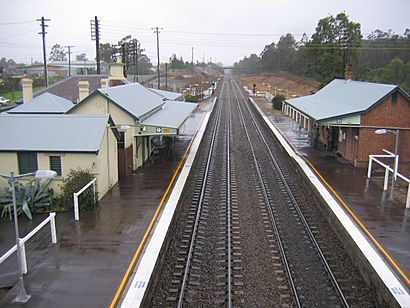Branxton railway station facts for kids
Quick facts for kids
Branxton
|
|||||||||||
|---|---|---|---|---|---|---|---|---|---|---|---|

Station looking east in August 2007
|
|||||||||||
| Location | Railway Street, Branxton Australia |
||||||||||
| Coordinates | 32°39′44″S 151°20′44″E / 32.662247°S 151.34562°E | ||||||||||
| Owned by | Transport Asset Holding Entity | ||||||||||
| Operated by | NSW TrainLink | ||||||||||
| Line(s) | Main Northern | ||||||||||
| Distance | 215.55 kilometres from Central | ||||||||||
| Platforms | 2 side | ||||||||||
| Tracks | 2 | ||||||||||
| Construction | |||||||||||
| Structure type | Ground | ||||||||||
| Other information | |||||||||||
| Station code | BNX | ||||||||||
| Website | Transport for NSW | ||||||||||
| History | |||||||||||
| Opened | 24 March 1862 | ||||||||||
| Traffic | |||||||||||
| Passengers (2013) | 10 (daily) (Sydney Trains, NSW TrainLink) | ||||||||||
| Rank | 286 | ||||||||||
| Services | |||||||||||
|
|||||||||||
Branxton railway station is a historic train station in New South Wales, Australia. It is located on the Main Northern line and serves the town of Branxton. The station first opened its doors on 24 March 1862. It is considered very important because of its history and was added to the New South Wales State Heritage Register on 2 April 1999.
In the past, there was an extra track called a "crossing loop" behind Platform 2. This loop allowed trains to pass each other or wait. However, it is no longer used today. Near the station, there is also a special track that leads to the Hunter Valley Railway Trust's museum in North Rothbury.
Contents
What Trains Stop Here?
Branxton station has two platforms, one for each direction of travel.
Platforms and Services
The station is served by NSW TrainLink Hunter Line trains. These trains travel between Newcastle, Muswellbrook, and Scone.
| Platform | Line | Stopping pattern | Notes |
| 1 |
NSW TrainLink
|
services to Newcastle | |
|---|---|---|---|
| 2 |
NSW TrainLink
|
services to Muswellbrook & Scone |
Station Buildings and Features
Branxton station has several interesting buildings and features that show its long history.
Platform Buildings
- Up Platform Building: This building is made of brick and was originally built in 1862. It was used as both an office for station staff and a home for them. It has been changed a few times over the years, in the 1880s and again in 1915.
- Down Platform Building: This brick building was added in 1915 when the railway line was made into two tracks. The edges of both platforms are also made of brick.
Other Historic Features
- Signal Box: There is a timber signal box with a sloped roof (called a skillion roof). It was built around 1915 and still has some old telegraph wires and poles. Signal boxes were used to control train movements.
- Other Structures: The station also has a timber store, a steel footbridge (from around 1915), and the concrete base of an old crane. You can also see old signs, seats, and fences from different times in the railway's history.
- Missing Items: An old weighing machine was once at the station but is no longer there. The original signals, which were installed in 1946, were replaced with newer ones around the year 2000.
Why is Branxton Station Historic?
Branxton railway station is very special because it has some of the oldest buildings on the northern railway line.
Importance of the Station
The large size of the station buildings shows how important Branxton town and its station once were. The original station building was rare because it included a home for the station master. Only a few stations in the state had this feature.
The station group also shows how railways changed over time. Buildings were added in the 1880s and 1914, making it a major railway hub. This mix of old and newer structures makes it one of the most interesting and important historic railway sites in New South Wales.
Heritage Listing Details
Branxton railway station was officially listed on the New South Wales State Heritage Register on 2 April 1999. This means it is protected because it meets certain important criteria:
- Uncommon History: The station has rare features related to the cultural history of New South Wales.
- Scientific Value: It is also important for scientific study, especially in understanding old railway technology.
- Architectural Value: The buildings are rare examples of railway architecture.
- Social Value: It holds a special place in the community's history.

